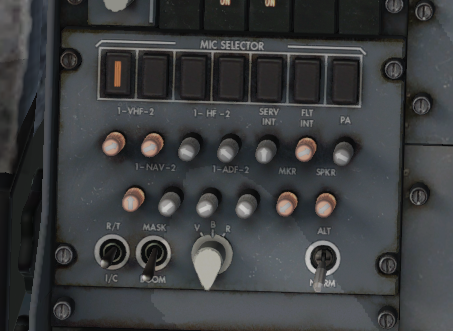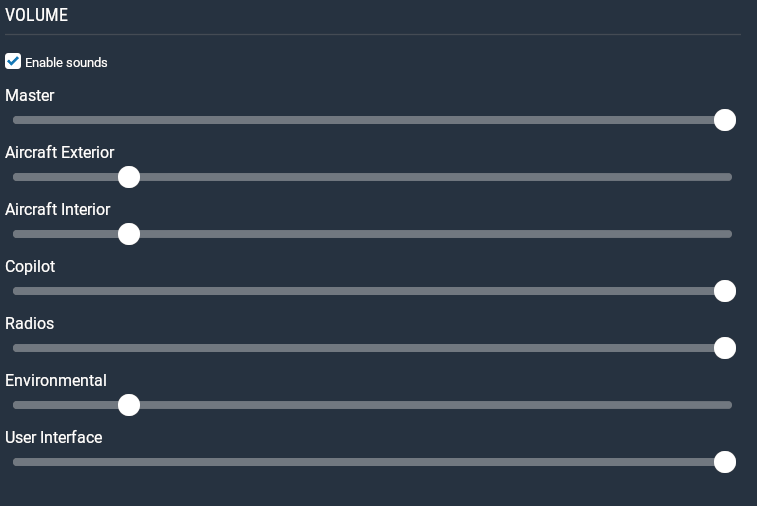-
Posts
87 -
Joined
-
Last visited
-
Days Won
1
Content Type
Profiles
Forums
Latest X-Plane & Community News
Events
Downloads
Store
Everything posted by Alpha Floor
-

Navaid Ident Volume too Low
Alpha Floor replied to Alpha Floor's topic in 737-300 Aircraft Systems and Operation
Good to know, thanks Jan! -
Hallo Jan, Thanks for your input. I am using the Saitek (Logitech now) X52 Pro and a bit of non-linearity towards the centre seems to help as the travel of this stick is about 30 degrees left/right. I believe the 737 yoke goes past 90 up to 100 degrees?
-
Sorry to bring up an old thread but, what are the recommened settings on X-Plane 11? The axes configuration menu is not quite the same...
-
Hello, Quick question. I was trying to identify the morse code of some navaids in flight and couldn't hear anything. On the ground, after engines off, I could hear a very low and faint ident pulse. Is there a way to increase the volume of the navaid idents? I tried turning the SPKR on to see if that had an influence. In the real aircraft the volume can be adjusted by rotating the knobs but that's not possible here.
-

How to make a kiss landing like Jan
Alpha Floor replied to cmbaviator's topic in Flight Procedures and Techniques
It's also interesting to note that this is the point at which the approach phase ends and the landing itself begins. The take-off on the other hand ends at 35 feet above the runway, point at which the 2nd climb segment starts (the first climb segment is from lift-off to 35ft, a bit misleading, but yeah). -

How to make a kiss landing like Jan
Alpha Floor replied to cmbaviator's topic in Flight Procedures and Techniques
That's interesting, I always thought that: Vapp = Vref + 1/2 the head-wind component + the full gust. Vapp should not be less than Vref+5 nor exceed Vref+20 On the Boeing 777 (and newer Boeings too probably), if AT is used, Vapp is always Vref+5. It's claimed that the AT is more than capable of adjusting against winds or gusts. If AT is not used, the above definition of Vapp applies. However, I found this "newer" document in which they mention the 1/3 component you said. This one is an Airbus document and they use Airbus terms, so I guess the "VLS" or "minimum selectable" is analogous to the "Vref" of a Boeing. The "minimum selectable speed" and the Vref are not exactly the same thing, though. VLS is the top of the amber band which in a Boeing is called "minimum maneuvering speed", the speed that grants 1.3g maneuver capability (40º of bank at level flight). But Vref on a Boeing is usually somewhat higher than the minimum maneuvering speed, it's not exactly on the top of the amber band. Maybe VLS and Vref are conceptually the same and it's just the definition of the amber band that's different between manufacturers. This whole discussion is for the "no-failures" scenario. -

How to make a kiss landing like Jan
Alpha Floor replied to cmbaviator's topic in Flight Procedures and Techniques
And that's fine. The speed never went below the bug. I re-watched it, and he didn't cross the threshold at 100. At 100ft you can clearly see the threshold in front of him. Minute 1:29 in the video. I'd say it was 70 (or even 65 feet, see minute 1:33). A little high, yes, but nothing too serious. He touched down in the touchdown zone without floating anyway. -

How to make a kiss landing like Jan
Alpha Floor replied to cmbaviator's topic in Flight Procedures and Techniques
I don't know about 200 feet, but you certainly should NOT be trimming during the landing itself (flare and touchdown). I don't like trimming below 500 feet anyway. At this point (latest) the approach should be stable. 1000 feet for precision approaches. -

How to make a kiss landing like Jan
Alpha Floor replied to cmbaviator's topic in Flight Procedures and Techniques
Looks perfectly fine to me Maybe not the most "elegant" landing because of centerline deviation, but whatever. Good one! -

How to make a kiss landing like Jan
Alpha Floor replied to cmbaviator's topic in Flight Procedures and Techniques
Do an Autoland and see how the Autopilot does it Also read the rest of the thread and watch the videos. -

How to make a kiss landing like Jan
Alpha Floor replied to cmbaviator's topic in Flight Procedures and Techniques
Just so you know guys: All FAR-25 certified transport category aircraft (like the 737) have a design vertical speed at touchdown of 600 fpm. This value is the limit load. The ultimate load is the limit one times 1.5. This means, any landing UNDER 600 fpm is a soft one. Above 600 fpm and under 900 fpm is a hard one, and above 900 fpm is an accident. At exactly 600 fpm you're landing at design conditions, so you should be perfectly fine (just joking) -
I agree! We could argue that we're using a superior flight simulation platform over the other one; let's also use the better operating system and become a minority within a minority! (I'm not trying to incite any debates, I accept the developer's sensible decision of being practical and releasing the product on the OS of the majority)
- 335 replies
-
Exactly! I think that's the proper definition of "slippery", an aircraft with a high lift-to-drag ratio. Hence, "slippery" and "aerodynamically efficient" are synonyms. Another fact is that the "slippery-ness" of an aircraft does not depend on its weight, at least directly. The L/D ratio of an aircraft is not a constant number, it depends on the aircraft's flight path vector (alpha and beta angles). So in level flight and for a constant speed, the weight will influence the angle of attack which will influence the L/D ratio. But if you keep the alpha constant with varying weight, the L/D ratio will not change. This is one of the hypothesis used to determine maximum range/endurance of aircraft, one of the control laws is called "constant alpha", and the alpha in question is the one of maximum L/D ratio.
-
By the way, this is a great article on Cost Index and Fuel Strategies, by Boeing's Aero Magazine: http://www.boeing.com/commercial/aeromagazine/articles/qtr_02_10/pdfs/AERO_FuelConsSeries.pdf
-
Gotcha! Thanks for that Jan!
-
Great thread! For the record: The first time I got into an FFS in 2007, it was an Airbus 320, I could take-off, fly and land just fine. The problem happened at rollout after landing where I skid off the runway because I didn't know how to properly use the rudder. I learnt something that day. Second time was in a 744 simulator. I did pretty well much to the instructors amazement, even with cross-winds and low visibility upon landing. Third time was recently in, again, an A320 simulator. This time I did pretty well, take-off, circuit and land. Most difficult is taxiing in my opinion. Also, the first time I got into a GA aircraft in real life, the instructor said "Okay, I'll let you taxi, and if I'm happy, I'll let you do the take-off". I did the take-off, aerobatics in flight and the landing all by myself! Pretty great day that was! My opinion is that a hardcore simmer will be able to fly and land the thing as long as all conditions are normal, i.e., good weather, no failures etc.
-
Thanks. Numbers were off the top of my head I'm not sure I understand this. Changes in CI will obviously change the cruise ECON SPD. But within the same CI, if the pilot doesn't input the wind information into the FMC then VNAV won't care about actual wind while in cruise and won't change the ECON SPD. Correct?
-
The enroute wind might influence cruising speeds, but that's a second order effect. The 737 is not a fast airliner. Classics cruise at .74 and NG's cruise at .78 Airbus 320 cruises at .80. 757/767 at .82. 777 at .84 and the fastest of all is the 747 at .86
-
Very interesting thread! I always thought it was the NG's the ones that were slippery, not the Classics! Jim: Those airliners you've flown, which ones where most slippery and which ones where less slippery? Is it true that the 727 could pretty much dive nose down and the speed would not come up? haha On the Classics I've heard that the speedbrakes are not very effective.
-
I think the order is: 1st) Mesh -> UHD Mesh by AltpiloX 2nd) Ortho Photoscenery to be laid on top of the mesh. 3rd) World2X-Plane 3D scenery to be laid on top of the photoscenery (2D)
-
Yes I do! It's a nice place to live in, for a year or two. After that it get's a bit tiring. The "Feria del Caballo" just ended last Sunday.
-
And I don't want to distract you from the noble practice of alcohol-drinking! hahaha Regards!
-
Certainly, that's precisely why I used the quoatation marks "". At least in Spanish we use those to denote that the writer is not meaning the exact text-book definition of the word. By more "advanced" I meant, basically, more "buttons" or more "functionality" (or at least, theoretically). May I ask however, what do you mean exactly by "If you don't have GPS you lose your position all the time during an approach when in manual mode"? I suppose it has to do with the inability of the FMC to update its position via VOR/DMEs when you're using the manual mode, right? But if you don't have a AUTO/MANUAL option, then you're always in MANUAL, so to speak, which doesn't make the navigation more precise anyway, right? Or is it the fact that the FMC issues annoying messages what bothers you about the "advanced" NAV tuner? Kind regards Shifty!
-
Roger! Thanks Jan!
-
Hi guys! I see from videos that the NAV receiver of the IXEG 733 is based upon this (or similar) airframe, in which as you see the NAV tuner consists exclusively of the frequency window and two dials for selecting the digits left and right of the decimal point. However, other 737 Classics have a more "advanced" NAV tuner with two windows: AUTO (left window) and MANUAL (right window). There's a switch that toggles AUTO/MANUAL NAV tuning mode. In AUTO, the FMC is in charge of tuning the navaid and an amber bar crosses whichever frequency is in the MANUAL window. In MANUAL, the AUTO window blanks and it's the pilot who selects the appropriate frequency. My question: Is it possible to choose between one system and the other? If not, is it planned as a future update? I guess there's just such a VAST combination of avionics/equipments on 737 Classic out there, allowing for all of the options would take a huge amount of resources that could be invested into other more time-effective tasks such as de-bugging etc.. This thread is just "out of curiosity" My sincere apologies if this has already been addressed. BTW: Would it be possible to know the exact airframe (tail number) after which the IXEG 733 is modeled?




